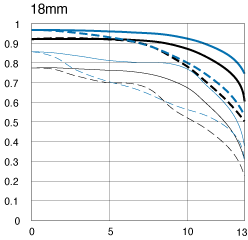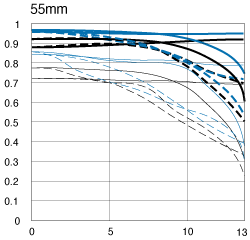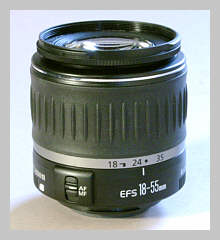
CANON EF-S 18-55 LENS REVIEW |
Canon EF-S 18-55/3.5-5.6 Lens Reviewby Bob Atkins
IntroductionNote: This review was written after testing the original EF-S 18-55 lens which was supplied in the US with the Canon EOS Digital Rebel (EOS 300D). In Japan this same lens was available with a USM motor, and now the USM version is available in the US and is being sold with the new Canon EOS 20D. The optics of the USM version are identical to the non-USM version, so the results and conclusions reached in these tests are applicable to both the USM and non-USM lenses
The EF-S 18-55/3.5-5.6 is an unusual Canon EOS lens. It is designed only to be mountable on the Digital Rebel (EOS 300D) body since it has a reduced image circle (enough for the Digital Rebel "APS-C" sized sensor, but not enough for full frame 35mm) and it sticks further into the camera body than a normal EF series lens. It is also fully compatible with the new Canon EOS 20D, which is currently the only other Canon EOS body designed to accept EF-S mount lenses.If you're prepared to do some surgery on this lens, you can modify it to work with an EOS 10D. There's a article right here on this website about how to make the modifications - Modifying and EF-S 18-55/3.5-5.6 for use on an EOS 10D The "S" in EF-S stands for "Short back focus". Back focus is the distance from the rearmost point of the last optical surface of the lens to the film or sensor. There are certain advantages in lens design in having this distance small for wide-angle lenses, but the limit in SLR cameras is determined by the requirement that the SLR mirror must not hit the lens when it flips up. The mirror on the Digital Rebel (and EOS 20D) is smaller than that of full frame 35mm cameras because the sensor is smaller and the mirror only needs to be large enough to cover the area of the sensor. This allows the use of a lens with a shorter back focus distance. Specifications
|
| Focal Length & Maximum Aperture: | 18-55mm 1:3.5-5.6 |
| Lens Construction: | 11 elements in 9 groups (1 aspheric element) |
Diagonal Angle of View: |
75° 20' - 27° 50' |
| Focus Adjustment: | Inner focusing system with MM |
| Closest Focusing Distance: | 0.28m / 0.92 ft. to infinity |
| Zoom System: | Rotating Type |
| Filter Size: | 58mm |
| Max. Diameter x Length, Weight: | 2.7" x 2.6", 6.7oz. / 69mm x 66.2mm, 190g |
Performance
The EF-S lens was greeted with what perhaps amounted to over expectations by some people. They reasoned that since it didn't have to cover the full 35mm frame and since it could be made to operate closer to the film than a standard lens, it's performance would be much better than expected for a $100 lens. Well, maybe, but what they failed to realize was that the reduced back focus distance is only present between about 18mm and 22mm. From 22mm up, the back focus distance of the lens isn't any shorter than can be used with a regular EF lens, and the image circle (or at least the illumination circle) is actually large enough to cover a full 35mm frame (though obviously not at high quality judging from the MTF curves below). The difference in minimum back focus distance between an EF lens and an EF-S lens is also pretty small. Maybe 1 or 2mm. So while reduced image coverage and shorter backfocus may help a little at the wide end, it's not really reasonable to expect them to make a $100 kit lens work like a $1000 "L" series lens! If you really want all the highly technical stuff, here are the MTF curves (from Canon, not from me!). The solid/dashed, blue/gray and thick/thin lines represent different apertures and spatial frequencies. These are explained on the Canon USA website. If you compare them with other Canon MTF charts, be sure to note that the horizontal axis only runs from 0 to 13mm, not 0 to 22mm because the lens is only specified for use with 22.7 x 15.1mm sensors which have an image circle of about 27mm (vs. 43mm for 35mm full frame)


Before anyone asks (and they will ask) "Why didn't you test it against the 24/2.8 or the 28.2.8 or the 28-135IS or the 35/2 or the 24-85 or any or all of the other Canon lenses covering between 18-55?", I'll tell you. I have a life and there's only so much time for lens testing. Plus I didn't actually have every other lens, plus - and this is the most important point of all - it's a $100 lens. You don't need to agonize over whether or not to buy it. If it's halfway decent and you want a general purpose lightweight lens for a Digital Rebel, it's good enough.
I should add that I actually tested two different EF-S 18-55 lenses, but all the images here are from one lens. While there were very minor differences in image quality between the two lenses, just as there are likely to be between any two lenses, they were small enough - certainly less than the differences between different lenses - that they would not affect any of the conclusions drawn in this article. I also took many more shots than you see here. The images reproduced in this article are examples. The text refelects the results from the full set of images.
So is it good enough....?
[NEXT: Performance at 18mm and 20mm]
© Copyright Bob Atkins All Rights Reserved
www.bobatkins.com

